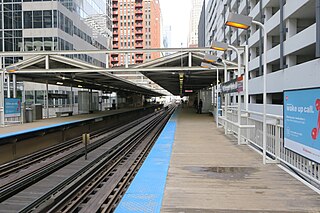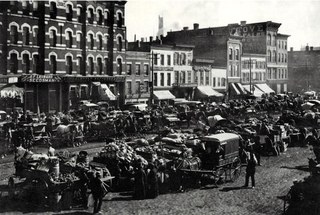
The Richard B. Ogilvie Transportation Center, on the site of the former Chicago and North Western Terminal, is a commuter rail terminal in downtown Chicago, Illinois. For the last century, this site has served as the primary terminal for the Chicago and North Western Railway and its successors Union Pacific and Metra. Intercity services had disappeared by the 1970s, but commuter services on the three ex-CNW mainlines, Metra's UP District lines, continue to terminate here. The tracks are elevated above street level. The old CNW terminal building was replaced in the mid 1980s with a modern skyscraper, the 500 West Madison Street building. The modern building occupies two square city blocks, bounded by Randolph Street and Madison Street to the north and south and by Canal Street and Clinton Street to the east and west. It is the second busiest rail station in Chicago, after nearby Union Station, the sixth-busiest railway station in North America, and the third-busiest station that exclusively serves commuter traffic.

The Chicago Pedway is a network of tunnels, ground-level concourses and bridges in Chicago, Illinois connecting skyscrapers, retail stores, hotels, and train stations throughout the central business district.

Randolph Street is a street in Chicago. It runs east–west through the Chicago Loop, carrying westbound traffic west from Michigan Avenue across the Chicago River on the Randolph Street Bridge, interchanging with the Kennedy Expressway (I-90/I-94), and continuing west. It serves as the northern boundary of Grant Park and the Chicago Landmark Historic Michigan Boulevard District. Several large theaters, as well as city and state government buildings are on and adjacent to Randolph. Metra's Millennium Station is located under Randolph Street.

Columbus Drive is a north–south street in Chicago, Illinois, which bisects Grant Park. It is 300 East in Chicago's street numbering system. Its south end is an interchange with Lake Shore Drive at Soldier Field. After intersecting Illinois Street, it becomes Fairbanks Court and continues to the north, terminating at Chicago Avenue.

Millennium Station is a major commuter rail terminal in the Loop (downtown), Chicago. It is the northern terminus of the Metra Electric District to Chicago's southern suburbs, and the western terminus of the South Shore Line to Gary and South Bend, Indiana.

The Metra Electric District is an electrified commuter rail line owned and operated by Metra which connects Millennium Station, in downtown Chicago, with the city's southern suburbs. As of 2018, it is the fifth busiest of Metra's 11 lines, after the BNSF, UP-NW, UP-N, and UP-W Lines with nearly 7.7 million annual riders. While Metra does not explicitly refer to any of its lines by color, the timetable accents for the Metra Electric District are printed in bright "Panama orange" to reflect the line's origins with the Illinois Central Railroad (IC) and its Panama Limited passenger train. Apart from the spots where its tracks run parallel to other main lines, it is the only Metra line running entirely on dedicated passenger tracks, with no freight trains operating anywhere on the actual route itself. The line is the only one in the Metra system with more than one station in Downtown Chicago, the only line with no stations in fare zone 4, and also has the highest number of stations (49) of any Metra line.
The Chicago Central Area Transit Plan, generally referred to as the Chicago Central Area Transit Project (CCATP) in the 1970s, was an extensive study of the rapid transit system in downtown Chicago; the study had begun in 1965.

Washington/Wells is a station on the Chicago "L" system, located in downtown Chicago, Illinois on The Loop. The station opened on July 17, 1995. Washington/Wells is located a few blocks from several major attractions and business centers, such as Chicago City Hall, the Civic Opera House, and the Chicago Mercantile Exchange. The station is also three blocks east of Ogilvie Transportation Center, terminal for the Union Pacific North, Northwest, and West line Metra trains. The station is located between Washington and Madison on Wells Street in downtown Chicago.

Randolph/Wabash was an elevated 'L' station in the Loop in Chicago. Located at Randolph Street and Wabash Avenue, it served trains running on the Chicago Transit Authority's Brown and Green Lines on the outer loop track, and the Green, Orange, Pink, and Purple Lines on the inner loop track. Randolph/Wabash was the closest 'L' station to Metra's Millennium Station until its closure on September 3, 2017. The station was later demolished.

Lake is an "L" station on the CTA's Red Line in the Chicago Loop that is part of the State Street subway. Lake is a transfer station between the Red Line and the Brown, Green, Orange, Pink, and Purple Lines at the State/Lake station and the Blue Line at Washington via the Chicago Pedway. In 2019, Lake had an average of 19,364 weekday passenger entries, making it the busiest 'L' station.

Washington is an 'L' station on the CTA's Blue Line. It is situated between the Clark/Lake and Jackson stations in the Milwaukee-Dearborn subway and is near the Richard J. Daley Center.
Fifth/Lake was a station on the Union Elevated Railroad's line, which is now part of the Loop section of the Chicago "L". The station was located at Fifth Avenue and Lake Street in downtown Chicago. Fifth/Lake opened on September 22, 1895, as one of three stations on the Lake Street Elevated Railroad's "Wabash extension". This extension became the Lake Street leg of the Loop upon its completion. Always intended to be temporary as Fifth Avenue was chosen to be the western leg of the Loop, the station closed on December 17, 1899, and was demolished shortly thereafter.

Madison/Wells was a station on the Chicago Transit Authority's Loop. The station was located at 1 North Wells Street in the Chicago Loop. Madison/Wells opened on October 3, 1897, and closed on January 30, 1994, and demolished so that work on the new Washington/Wells station could begin. This station and Randolph/Wells were replaced by Washington/Wells. The station was located at Madison Street and Wells Street in the Chicago Loop.

Washington/Wabash is an 'L' station on the CTA's Brown, Green, Orange, Pink, and Purple Lines. The station opened on August 31, 2017. It serves as a consolidation and replacement of the Randolph/Wabash and Madison/Wabash stations. The project was undertaken by the Chicago Department of Transportation. Construction of the $75 million station began in 2015, following the closure of Madison/Wabash in March 2015 and was completed in August 2017. The station is located between Washington and Madison Streets on Wabash Avenue in the Loop.

The Lake Street Elevated, also known as the Lake branch, is a 8.75 mi (14.08 km) long branch of the Chicago "L" which is located west of the Chicago Loop and serves the Green Line for its entire length, as well as the Pink Line east of Ashland Avenue. As of February 2013, the branch serves an average of 27,217 passengers each weekday. It serves the Near West Side, East Garfield Park, West Garfield Park, and Austin neighborhoods of Chicago, as well as the suburbs Oak Park and Forest Park. It owes its name to Lake Street, the street that the branch overlooks for 6.25 mi (10.06 km) before continuing its route straight west, adjacent to South Boulevard, towards the terminus at Harlem/Lake.

Fulton Market District is on the Near West Side of Chicago. In the 19th and 20th centuries, it served meat-packing, warehouse and industrial purposes, but has gentrified in the 21st century with corporate headquarters, tech industry, hotels, bars, restaurants, and retail. Randolph Street and Lake Street are the main East-West streets, and Halsted Street the major North-South artery. The district's name commemorates American inventor Robert Fulton and it is just across the expressway from the Fulton River District to the east.
The Illinois Central West Line was a commuter line operated by the Illinois Central Railroad between the Randolph Street Station in Chicago and Addison, Illinois. The service began in 1892 and ended in 1931.
The Randolph Street Branch and Cuyler Avenue Shuttle were two different incarnations of a rapid transit line operated in and around Oak Park, Illinois, a suburb of Chicago, by the Lake Street Elevated intermittently between 1899 and 1912. The Randolph Street Branch served as the line's westward extension to Wisconsin Avenue from Lombard Avenue, whereas the Cuyler Avenue Shuttle was intended to serve the Harlem Race Track. Local opposition resulted in the lines being discontinued.
In the first half of the 20th century, the four companies of the Chicago "L" and their successors each ran a terminal in Chicago's downtown in addition to the looping elevated trackage known as "the Loop" shared between all four of them. These terminals were the Congress Terminal of the South Side Elevated Railroad, the Market Street Terminal of the Lake Street Elevated, the eventual Wells Street Terminal of the Metropolitan West Side Elevated Railroad, and the North Water Terminal of the Northwestern Elevated Railroad. The Lake Street uniquely had an intermediate station on Randolph Street between its stub terminal and main line.















